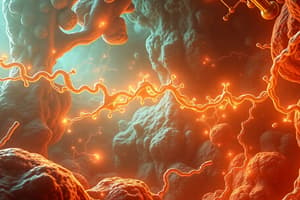Podcast
Questions and Answers
What is the primary function of the pentose phosphate pathway?
What is the primary function of the pentose phosphate pathway?
- Oxidation of fatty acids
- Production of glucose from non-carbohydrate sources
- Generation of NADPH and ribose 5-phosphate (correct)
- Synthesis of ATP
Which of the following tissues is NOT mentioned as being particularly important for the pentose phosphate pathway?
Which of the following tissues is NOT mentioned as being particularly important for the pentose phosphate pathway?
- Adipose tissue
- Liver
- Muscle tissue (correct)
- Testes
What is a product of the irreversible oxidative reactions in the pentose phosphate pathway?
What is a product of the irreversible oxidative reactions in the pentose phosphate pathway?
- Ribose 5-phosphate
- 2 NADPH (correct)
- Fructose 6-phosphate
- Glyceraldehyde 3-phosphate
How does glucose 6-phosphate dehydrogenase facilitate the pentose phosphate pathway?
How does glucose 6-phosphate dehydrogenase facilitate the pentose phosphate pathway?
Which metabolic process utilizes ribose 5-phosphate produced by the pentose phosphate pathway?
Which metabolic process utilizes ribose 5-phosphate produced by the pentose phosphate pathway?
What is the primary regulation point of the pentose phosphate pathway?
What is the primary regulation point of the pentose phosphate pathway?
Which of the following is a clinical manifestation of G6PD deficiency?
Which of the following is a clinical manifestation of G6PD deficiency?
How is G6PD deficiency primarily inherited?
How is G6PD deficiency primarily inherited?
What evolutionary advantage has been associated with G6PD deficiency in female carriers?
What evolutionary advantage has been associated with G6PD deficiency in female carriers?
What is the consequence of G6PD deficiency on red blood cells?
What is the consequence of G6PD deficiency on red blood cells?
Flashcards
Pentose Phosphate Pathway function
Pentose Phosphate Pathway function
A metabolic pathway that produces NADPH and ribose-5-phosphate, essential for various biosynthetic processes and nucleotide synthesis.
NADPH function
NADPH function
A biochemical reductant, crucial for biosynthesis of fatty acids and steroid hormones, and maintaining reduced glutathione in red blood cells.
Glucose 6-Phosphate Dehydrogenase (G6PD) role
Glucose 6-Phosphate Dehydrogenase (G6PD) role
Enzyme that catalyzes the irreversible oxidation of glucose 6-phosphate, the starting point of the pentose phosphate pathway.
Pentose Phosphate Pathway location
Pentose Phosphate Pathway location
Signup and view all the flashcards
Glucose 6-Phosphate deficiency effect
Glucose 6-Phosphate deficiency effect
Signup and view all the flashcards
Pentose Phosphate Pathway Regulation
Pentose Phosphate Pathway Regulation
Signup and view all the flashcards
G6PD Deficiency
G6PD Deficiency
Signup and view all the flashcards
G6PD Deficiency Cause
G6PD Deficiency Cause
Signup and view all the flashcards
G6PD Deficiency Symptoms
G6PD Deficiency Symptoms
Signup and view all the flashcards
G6PD Deficiency Evolutionary Advantage
G6PD Deficiency Evolutionary Advantage
Signup and view all the flashcards
Study Notes
Pentose Phosphate Pathway (Lecture 23)
- The pentose phosphate pathway, also called the hexose monophosphate pathway or 6-phosphogluconate pathway, occurs in the cytosol of cells.
- It involves two irreversible oxidative reactions followed by reversible sugar-phosphate interconversions.
- No ATP is directly consumed or produced in the pathway.
Specific Objectives
- Understand the function of the pentose shunt.
- Explain the effect of glucose 6-P dehydrogenase deficiency.
Pathway Overview
- The pentose pathway is a shunt from glycolysis.
- The pathway generates NADPH, a crucial biochemical reductant.
- It produces ribose-5-phosphate, essential for nucleotide synthesis.
- It provides a mechanism to utilize five-carbon sugars from the diet or carbohydrate breakdown.
Irreversible Oxidative Reactions
- The oxidative portion produces ribulose-5-phosphate, CO2, and two NADPH molecules per glucose-6-phosphate oxidized.
- One glucose-6-phosphate oxidized yields two NADPH.
Oxidative Stages
- Glucose-6-phosphate is oxidized by glucose-6-phosphate dehydrogenase.
- 6-phosphogluconolactone is hydrolyzed by gluconolactonase.
- 6-phosphogluconate is oxidized by 6-phosphogluconate dehydrogenase, producing CO2.
- Resulting ribulose-5-phosphate can be converted to ribose-5-phosphate (necessary for nucleotide synthesis).
Site of Action
- Important in liver, lactating mammary glands, and adipose tissue for fatty acid synthesis.
- Important in testes, ovaries, placenta, and adrenal cortex for steroid hormone synthesis.
- Important in red blood cells (RBCs) to maintain reduced glutathione.
Reversible Nonoxidative Reactions
- Occurs in all cell types synthesizing nucleotides and nucleic acids.
- Enables ribulose-5-phosphate conversion to ribose-5-phosphate for nucleotide synthesis, or to glycolysis intermediates.
Glucose-6-Phosphate Dehydrogenase (G6PD) Deficiency
- G6PD deficiency is an inherited disease characterized by hemolytic anemia due to the inability to detoxify oxidizing agents.
- G6PD deficiency inhibits RBCs from producing NADPH, which leads to hemolysis.
- This deficiency is X-linked and results from multiple mutations.
- Symptoms can include neonatal jaundice and a shorter lifespan in severe cases.
- Resistance to falciparum malaria is observed in female carriers.
Studying That Suits You
Use AI to generate personalized quizzes and flashcards to suit your learning preferences.
Related Documents
Description
This quiz covers the pentose phosphate pathway, highlighting its significance in cellular metabolism. Understand the function of the pathway, its oxidative reactions, and the implications of glucose 6-P dehydrogenase deficiency. Test your knowledge on the generation of NADPH and ribose-5-phosphate.




